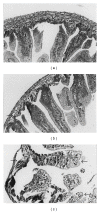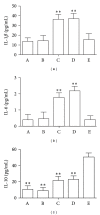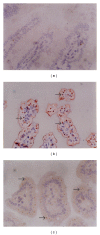Recombinant human trefoil factor 3 ameliorates bowel injury: its anti-inflammatory effect on experimental necrotizing enterocolitis
- PMID: 24688551
- PMCID: PMC3944653
- DOI: 10.1155/2014/634135
Recombinant human trefoil factor 3 ameliorates bowel injury: its anti-inflammatory effect on experimental necrotizing enterocolitis
Abstract
Aim. Recombinant human trefoil factor 3 (intestinal trefoil factor) has been suggested to be partially protective against necrotizing enterocolitis (NEC), but the mechanisms of this protection have not been defined. We investigated whether the protective effects of rhTFF3 are the result of an anti-inflammatory response. Methods. The rats were killed on day 4, the distal ileum was harvested for morphological studies and immunohistochemistry for NF- κ B (p65), and the amounts of IL-1 β , IL-6, and IL-10 in the intestinal tissue were measured using commercial ELISA assay kits. Results. In the neonatal NEC, IL-1 β , IL-6, and IL-10 were significantly higher than in normal group. In normal group, IL-1 β and IL-6 were significantly decreased, and the amount of IL-10 was markedly increased compared with NEC group. In the NEC model, immunohistochemical staining for NF- κ B (p65) was demonstrated to be of a strong brown color and was distributed in the intestinal epithelium. Treatment with rhTFF3 significantly decreased the immunoreactivity of NF- κ B (p65) in the NEC model. Conclusions. Intestinal inflammation was ameliorated after rhTFF3 was injected. rhTFF3 may protect against the intestinal injury of the neonatal rat NEC model by suppression of the inflammatory response.
Figures



Similar articles
-
The therapeutic effect of recombinant human trefoil factor 3 on hypoxia-induced necrotizing enterocolitis in immature rat.Regul Pept. 2003 Nov 15;116(1-3):53-60. doi: 10.1016/s0167-0115(03)00177-0. Regul Pept. 2003. PMID: 14599715
-
Insulin-like growth factor I reduces the occurrence of necrotizing enterocolitis by reducing inflammatory response and protecting intestinal mucosal barrier in neonatal rats model.Eur Rev Med Pharmacol Sci. 2017 Oct;21(20):4711-4719. Eur Rev Med Pharmacol Sci. 2017. PMID: 29131241
-
Maternal N-acetyl-cysteine prevents neonatal brain injury associated with necrotizing enterocolitis in a rat model.Acta Obstet Gynecol Scand. 2021 May;100(5):979-987. doi: 10.1111/aogs.14054. Epub 2021 Jan 12. Acta Obstet Gynecol Scand. 2021. PMID: 33247942
-
Early enteral stressors in newborns increase inflammatory cytokine expression in a neonatal necrotizing enterocolitis rat model.Eur J Pediatr Surg. 2013 Feb;23(1):39-47. doi: 10.1055/s-0032-1329704. Epub 2012 Nov 19. Eur J Pediatr Surg. 2013. PMID: 23165517 Free PMC article.
-
Anti-inflammatory mechanisms of bioactive milk proteins in the intestine of newborns.Int J Biochem Cell Biol. 2013 Aug;45(8):1730-47. doi: 10.1016/j.biocel.2013.04.028. Epub 2013 May 6. Int J Biochem Cell Biol. 2013. PMID: 23660296 Review.
Cited by
-
Biomarkers of gut injury in neonates - where are we in predicting necrotising enterocolitis?Front Pediatr. 2022 Nov 28;10:1048322. doi: 10.3389/fped.2022.1048322. eCollection 2022. Front Pediatr. 2022. PMID: 36518779 Free PMC article. Review.
-
Trefoil Factor Peptides and Gastrointestinal Function.Annu Rev Physiol. 2017 Feb 10;79:357-380. doi: 10.1146/annurev-physiol-021115-105447. Epub 2016 Dec 15. Annu Rev Physiol. 2017. PMID: 27992733 Free PMC article. Review.
-
Pathological and therapeutic roles of bioactive peptide trefoil factor 3 in diverse diseases: recent progress and perspective.Cell Death Dis. 2022 Jan 17;13(1):62. doi: 10.1038/s41419-022-04504-6. Cell Death Dis. 2022. PMID: 35039476 Free PMC article. Review.
-
The Role of Mucosal Defense in Intestinal Injury of Infants With Fetal Growth Retardation.Iran J Pediatr. 2016 Feb;26(1):e460. doi: 10.5812/ijp.460. Epub 2016 Jan 30. Iran J Pediatr. 2016. PMID: 26848381 Free PMC article.
-
Effect of Initial Periodontal Therapy on Salivary Trefoil Factor (TFF3) in otherwise Healthy Patients with Gingivitis and Chronic Periodontitis.Contemp Clin Dent. 2018 Jun;9(Suppl 1):S11-S16. doi: 10.4103/ccd.ccd_665_17. Contemp Clin Dent. 2018. PMID: 29962757 Free PMC article.
References
-
- Somaschini M, Breda-Klobus A, Pacati I. Necrotizing enterocolitis (NEC): risk factors and genetic susceptibility. Minerva Pediatrica. 2012;64(1):33–40. - PubMed
-
- Berman L, Moss RL. Necrotizing enterocolitis: an update. Seminars in Fetal and Neonatal Medicine. 2011;16(3):145–150. - PubMed
-
- Anand RJ, Leaphart CL, Mollen KP, Hackam DJ. The role of the intestinal barrier in the pathogenesis of necrotizing enterocolitis. Shock. 2007;27(2):124–133. - PubMed
-
- Thompson AM, Bizzarro MJ. Necrotizing enterocolitis in newborns: pathogenesis, prevention and management. Drugs. 2008;68(9):1227–1238. - PubMed
LinkOut - more resources
Full Text Sources
Other Literature Sources

